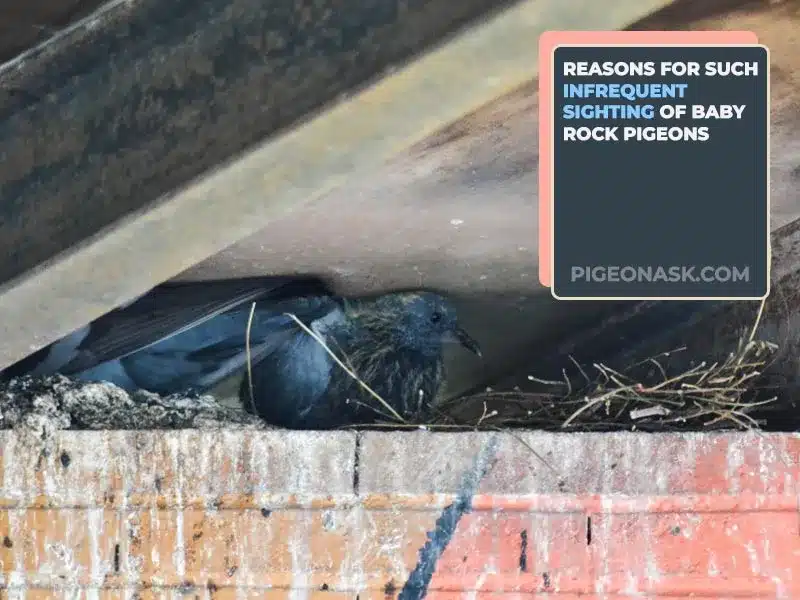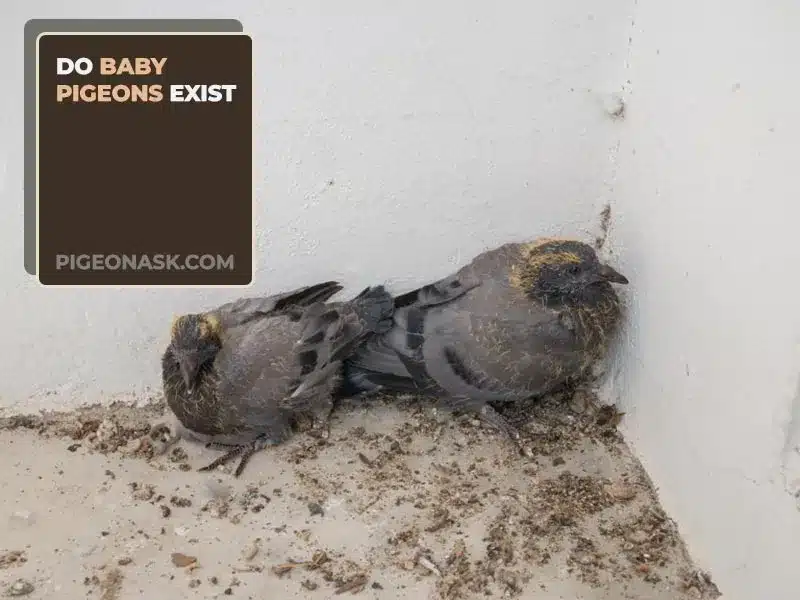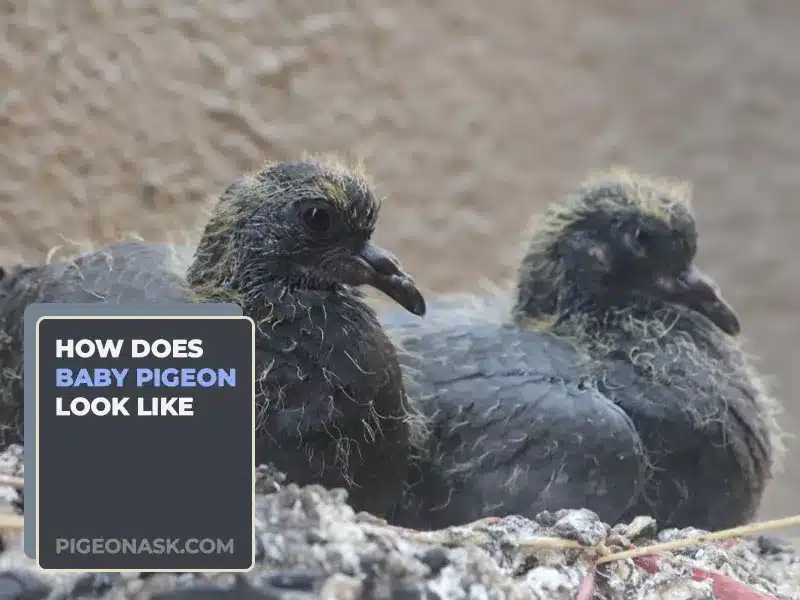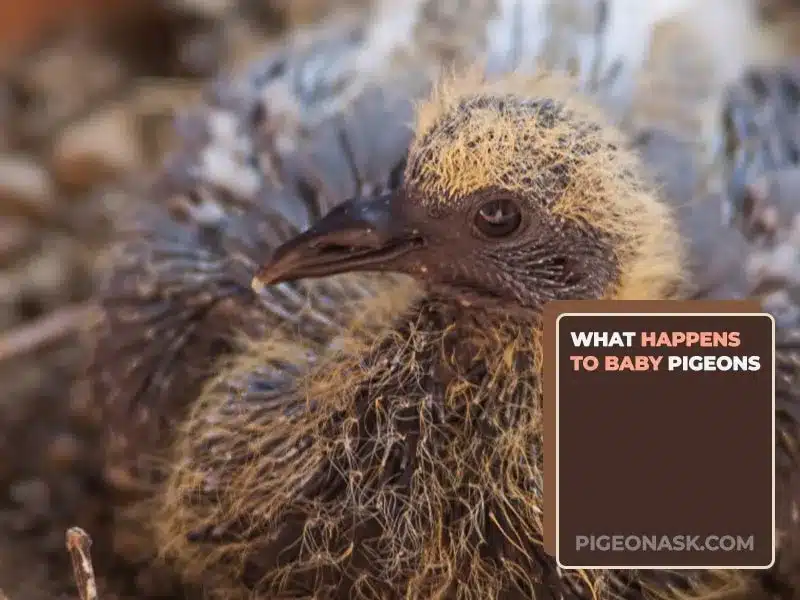Why Do You Never See Baby Pigeons?
You probably live in a big city where hundreds of rock pigeons swarm around you, and if you are unlucky, they might even snatch your leftover pizza and fly off.
These feathery birds are seen everywhere, but why do you never see baby pigeons? Well, baby pigeons or squabs are one of the most spoiled species you will ever come across. They tend to dwell in the comfort zone for most of their young and juvenile age, provided by their mother.
The mother pigeon incubates her squabs for almost 3 weeks to keep them warm and protect them from light sensitivity. Since pigeons are very attentive and solicitous to their babies, they ensure keeping them shielded and away from human attention.
That’s why you will never see pigeon babies until they reach adulthood and becomes ready to fend for themselves. To put more emphasis on this topic, I have discussed all the nitty-gritty details of baby pigeons in this post. So, let’s find out why do you never see baby pigeons, shall we?
Looking for more articles about pigeon parenting:
3 Reasons for Such Infrequent Sighting of Baby Rock Pigeons
As you have already discovered that baby pigeons don’t leave the nest until they are full-grown adults, and that’s the very reason you don’t catch sight of them.

However, with all honesty, there are other reasons too as to why you never see baby pigeons. Let’s have a look
1. The Pigeons Hate Unnecessary Attention and Chaos
Pigeona are prone to build their nest on rooftops, in high-rising constructions, under the gutter, inside the attics, above the chimneys, or in other skyscraping territories.
Their nests are mostly out of the view of humans, and they love to keep it that way. Hence you never see them lying or resting on the ground like other baby birds.
According to Devokaitis, even though the rock fledgling pigeons hop out of their nest, you still won’t be able to see them as they will be out of view. On the flip side, other songbirds with less lofty nests can be seen on the ground, sitting on a bush, or somewhere comfortable shortly after they fledge.
She also mentioned that by the time juvenile pigeons have more resemblance to adults than other birds when they abandon the nest. Devokaitis said if you keep an eye out, though, you may be able to spot these young’uns: look for feathers that aren’t completely molted, dark eyes(adults have red-orange eyes), and tapered primary feathers(the longest feathers on the bird’s wing).
2. Rock Pigeons Grow Faster Than Other Song-Birds
Compared to other birds, pigeons spend a relatively long time as nestlings, and they grow up way faster than any other birds. So even if you live in a city full of rock pigeons, by the time you encounter a baby pigeon, maybe it will be already late as their transformation happens faster, and we can’t discriminate between an adult pigeon and a nearly young pigeon.
3. Baby pigeons Prefer Staying With Their Mother
As mentioned earlier, squabs are spoiled by their parents. Whereas most songbirds spend two to three weeks inside the nest, these spoiled brats stick to their nest for at least three weeks to six weeks max. They love the comfort provided by their mother, and some pigeons refuse to leave the nest even after reaching adulthood. I
Do Baby Pigeons Exist?
It’s quite funny to ponder over the existence of baby pigeons, as under the threshold, we all know they are present! Right?
But see, the eyes believe what they see, and since you have almost never seen a baby pigeon, it’s hard to believe that they are lurking around somewhere.

Now, for starters, yes, baby pigeons exist, and you can witness them with your bare eyes if you really look inside their nest.
Baby pigeons are defenseless, unable to fly and search for food till they are four weeks old. And during this time, they never leave the nest.
Well, maybe every now and then will bob their head or peep outside to have a quick glance over the surroundings, but truth be told, they hate drawing human attention and prefer to stay inside.
Where do Baby Pigeons Rest inside the Nest?
The squabs are mostly resting under their mother’s body, inside the nest untill they are about four weeks old.
Whenever the parent pigeons sense any strange noise or activities happening around their haven, they hide their squabs under their bodies and try to protect them from any potential predator attack.
Besides, baby pigeons are addicted to their mother’s warmth and care. They burrow themselves under the mother’s belly in the act of hiding themselves from the outside world.
The mother and father both take part in incubating their squabs as one has to look out for food, leaving the nest. They make sure the babies are safe, warm, and fed until they reach maturity.
In about 4 weeks, the baby pigeons start to flap their wings in pursuit of flying, and they will even make small attempts to elevate from the ground.
That’s when the parent pigeons supervise them in flying and hunting for food. At around 6 weeks of age, they become ready to fly and leave the nest for the time being.
How Does Baby Pigeon Look Like?
The body of baby pigeons is bereft of feathers or any kind of natural clothing. They have dark or pink skin and are almost bald.
However, there are some hints of patchy yellow fuzz plastered on their body which will eventually transform into fully grown feathers. Their beak is long, flat, and pink with fleshy nose wattles.
They have no feathers under their wings, and their feet are grey and relatively larger than their entire body, proportion-wise.

Looking at the description of how they look, do you think you have ever seen one? Well, maybe not because you only witness them when they are adults and covered with feathers, just like other pigeons.
They grow up faster than any other birds, at least appearance-wise. And that can be one of the reasons why it never really occurs to you what baby pigeons look like or how they are supposed to look.
Hence, unless you voluntarily investigate the pigeon nest, you can’t really see baby pigeons.
Debra Krinsky, A conversation biologist with NYX Audubon Society, outlined to IFL Science that Only if you can see into a nest would you be likely to see baby pigeons. By the time they leave the nest, they are already quite large and resemble adult birds more than they do chick.
What Happens to Baby Pigeons?
Personally, I would like to entertain the idea that some fairy steals the baby pigeons and disappear into an abyss, and that’s why we never see a baby pigeon.
But gladly, that doesn’t happen. Baby pigeons grow up in a very loving atmosphere where they have attentive parents who look after them and teach them how to survive with humans.

Before they learn to defend themselves, their parents won’t ever let them face the world. When the young pigeons reach adulthood and learn everything that’s necessary to cope, they leave the nest and try to attract their courters by making an attractive cooing sound.
Once they find their prospect, they mate with them and bring new lives to this world. As they are monogamous, they mate for life, and that’s how the cycle continues.
End Quote
Next time you wonder why do you never see baby pigeons make sure you look under the city bridges or the high-rising buildings and their rooftops. Well, that’s where they are supposed to be, inside the cozy nests built by their parents.
Also, make sure you look under the mother pigeon’s belly to spot the squabs, as baby pigeons spend their incubation period there.
Taking in the necessary warmth from their mother, these baby pigeons gradually move forth to the juvenile stage. They learn to wriggle, walk, flap their wings, hunt little bugs to suffice their hunger, reach adulthood and become ready to face the real world.
Article References:
- Audubon.org/news/why-do-we-never-see-baby-pigeons
- Birdspot.co.uk/bird-brain/why-dont-you-see-baby-pigeons
- Earthlymission.com/why-we-never-see-baby-pigeons-adorable-cute/
Image credits: Canva.com/photos
